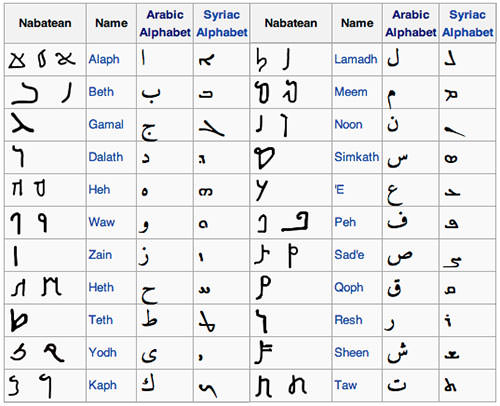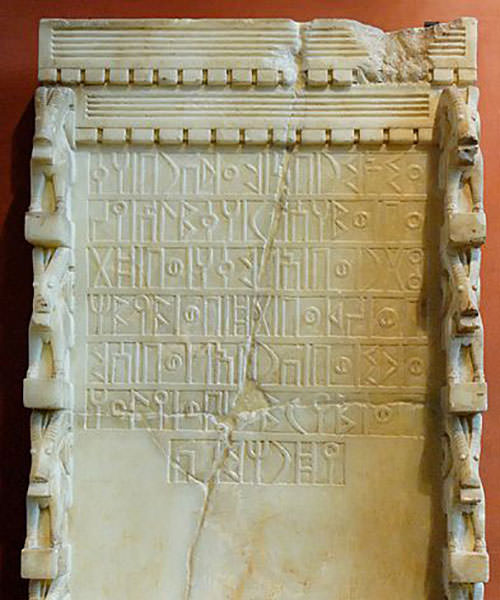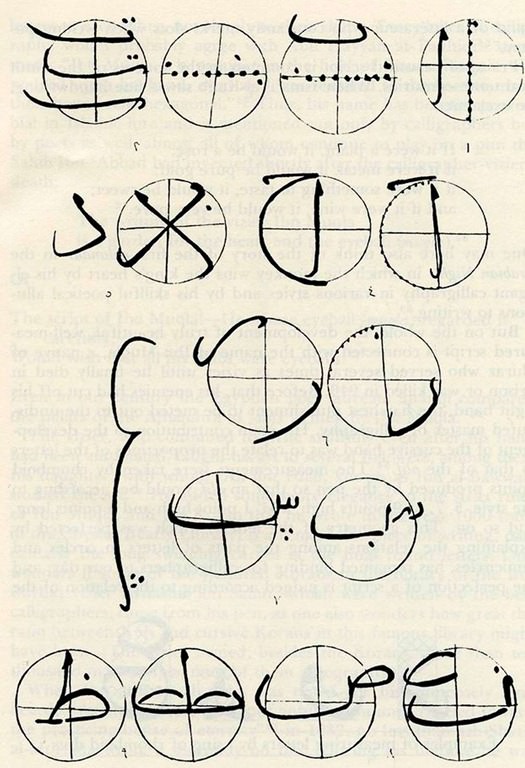Arabic calligraphy was originally a tool for communication, but with time, it began to be used in architecture, decoration and coin design. Its evolution into these major roles was a reflection of the early Muslims’ need to avoid, as their beliefs required, figures and pictorials that were used as idols before Islam was established in the Arabian Peninsula.
While the Arabic tribes preferred to memorize texts and poetry, the first Muslims tried to document their holy book (Qur’an Kareem) using the scripts that we’ll look at in this article. In order to understand how these scripts developed into the beautiful and complex shapes we know today, we have to understand the history of Arabic calligraphy.
Over the course of their development, the Arabic scripts were created in different periods and locations of the expansive Islamic Empire. There is also a close relationship between each Arabic script and its common usage throughout history. This leads us to the question of why this article is important, especially for non-Arabic speakers, and what information can be gleaned from each script.
Well, understanding the history of each script and how Arabic calligraphy evolved over the history of the Islamic Empire can expand our visual experience beyond the beautiful glyphs and forms. Some scripts reflect the time period in which they developed, such as the Musand script, which emerged at an early stage in the history of Arabic calligraphy. Others provide geographical insight into where the artwork was developed, such as the Maghribi script, which distinguishes the artwork and inscriptions of northwest Africa.
Can different scripts tell us more information, such as the geographical area where each was developed? How much is the local culture affected by each script? We will try to answer these questions, while briefly going through the history and style of each script.
Further Reading on SmashingMag:
- The Art And Craft Of Arabic Type Design
- A Type Design Brief: What Is In It, And Why Does It Matter?
- Showcase Of Web Design In The Arab World
- Writing Systems And Calligraphy Of The World
- Type Design Is Not Only About Drawing Letters
The Early Development Of Arabic Scripts
Digging deep into the history of the Arabian Peninsula and the origin of the Arabic language, archeologists have found inscriptions that show a close relationship between Arabic scripts and some earlier scripts, such as the Canaanite and Aramaic Nabataean alphabets that were found in the north of the Arabian Peninsula. These inscriptions were date to the 14th century BC.

Arabic Musnad
The first Arabic script, Arabic Musnad, which likely developed from the above-mentioned languages, doesn’t have the cursive aesthetic that most people associate with modern Arabic scripts. Discovered in the south of the Arabian Peninsula, in Yemen, this script reached its final form around 500 BC and was used until the 6th century. It did not look like modern Arabic, as its shapes were very basic and resembled more the Nabataean and Canaanite alphabets than the Arabic shapes.

Al-Jazm
The first form of an Arabic-like alphabet is known as the Al-Jazm script, which was used by northern tribes in the Arabian Peninsula. Many researchers think the roots of this script go back to the Nabatean script, and yet the early Arabic scripts also seem to have been affected by other scripts in the area, such as the Syriac and Persian scripts.
The Al-Jazm script continued to develop until the early Islamic era in Mecca and Medina in the west of the Arabian Peninsula.

The Al-Jazm script developed into different styles, such as the Hiri, Anbari, Makki and Madani. During this period, some other scripts developed, such as the Ma’il, which is considered the predecessor of the Kufic script. Other scripts did not make it through the development process, such as the Mukawwar, Mubsoott and Mashq (which you can read more about in “The Development of the Arabic Script: A Brief History” by professor M.J. Alhabeeb of the University of Massachusetts Amherst). Usually, these scripts were used before and during the early days of the Islamic Empire in the Arabian Peninsula.
Kufic Script
Following the Arabic Musnad and Al-Jazm, the Kufic script evolved as the next stage of Arabic calligraphy’s development. Unlike those two old scripts, we can identify known letter shapes in the early development of the Kufic script.
As the Kufic script developed over the 7th century, it played an essential role in documenting the Muslim holy book (Qur’an Kareem). The Kufic script is one of the oldest Arabic scripts that persisted in common use until the 13th century.
Its name refers to the city of Kufa in Iraq, where it first appeared, yet most instances of this script were found nearly a thousand kilometers to the south in Medina in the Arabian Peninsula, where the Prophet Mohammed stayed after moving from Mecca.
In the early stages of its development, the Kufic script did not include the dots that we know from modern Arabic scripts. The letter dots (Nuqat) were added during the later development of this and other scripts. Also, at a later stage, Abul Aswad Al Du’ali (688 CE) and Al Khalil Ibn Ahmed Al Farahidi (786 CE) developed the diacritical marks (Tashkeel) that indicate the vowels of the letters.
If we examine Kufic script inscriptions, we’ll notice particular characteristics, such as the angular shapes and long vertical lines. The script letters used to be wider, which made writing long content more difficult. Still, the script was used for the architectural decoration of buildings, such as mosques, palaces and schools.
These characteristics affected the usability of the script and made it more suitable for architectural and written Islamic titles, instead of long texts.
The Kufic script continued its development through the different dynasties, including the Umayyad (661 – 750 CE) and Abbasid (750 – 1258 CE) dynasties. Below are some examples of Kufic scripts and their different developmental stages:




While Kufic has been used for a long time and is one of the more common scripts across the Islamic civilization, some versions of it were developed in particular areas, such as Egypt and Iraq. Understanding how the script developed in different areas and being able to identify each variation of it will help us identify the origins of the artifacts where they appear. Variations and developments of the Kufic script include the following:
- The thick Kufic script. This is one of the earliest forms of the Kufic script and was used in the early copies of the Holy Qur’an, known as the Uthman Qur’an.
- Magribi Kufic script. This script was used in Morocco and includes curves and loops, unlike the original Kufic script.
- Mashriqi Kufic Script. The letters in this script are similar to the original Kufic, with a thinner look and decorative lines.
- Piramouz script. This script is another version of the Mashriqi script that was developed in Iran.
- Ghaznavid and Khourasan scripts. These two other forms of the Kufic script were developed in Iran. These scripts have the same thickness as the original Kufic script, with long vertical lines and decorative ends.
- Fatimid Kufic. This form developed in North Africa, especially in Egypt. It was written in thick lines and short curves.
- Square Kufic. This form is very noticeable, with its straight letters and no curves at all.
As an Egyptian citizen, resident in Cairo, I enjoy the Fatimid Kufic as part of my daily life because it can be seen in the architectural decorations on the old Islamic buildings. This script was used with decorative motifs in the characters themselves or as a background. The letters are marked with straight lines and angles, with short curves for some letters at the ends of words. One of the leading scholars and an award-winning researcher in the Fatimid Kufic script is Bahia Shehab, Professor of Professional Practice at the American University in Cairo.


Abbasid Dynasty
After the Umayyad dynasty came the Abbasid dynasty (750 – 1258 CE), bringing advancements to Arabic calligraphy. During this period, Thuluth and Naskh were developed. The three calligraphers responsible for these developments were Ibn Muqlah, followed by Ibn Al Bawwab (11th century) and Yaqut Al Musta’simi (13th century).
Ibn Muqlah restricted the scripts’ proportions to six cursive styles, including the Thuluth, Naskh and Muhaqqaq. These rules are based on four elements: the rhombic dot, the alif, the circle and the similarity system. These changes helped to develop the Kufic script with the cursive styles shown below.



Thuluth Script
The name “Thuluth” means one third, which might refer to the size of the pen used to write the script. It is one of the cursive scripts that was commonly used to decorate mosques and different types of texts.
The Thuluth script was first developed in the 11th century during the Abbasid dynasty and was refined by calligrapher Seyh Hamdullah during the Ottoman dynasty. It is the basis of scripts that appear later, such as the Jeli Thuluth, the Naskh and the Muhaqqaq, the last two of which we will cover later in this article.
The Thuluth script is marked by its clear structure and readability, which make it suitable for a number of purposes, even today. The cursive letters and long lines make it easily readable and usable for both titles and long texts.
Therefore, it was used in the Holy Qur’an and in architectural decorations in many regions of the Islamic Empire. Below are some examples of the Thuluth script.



Naskh Script
During the same period, the 10th century, another main script was developed. Used to copy books, especially the Holy Qur’an, Naskh, which means “copy,” was later refined by Islamic calligraphy master Seyh Hamdullah (1436 – 1520) during the Ottoman dynasty.
Known for its readable glyphs, the Naskh was traditionally used for long texts and inscriptions. Its use continues today in the design of printed Arabic books, due to its modern look and cursive letters.


Safavid Dynasty
After the Abbasid dynasty, the Safavid dynasty (1502 – 1736) was established in Persia and made substantial contributions to Islamic arts and calligraphy. It developed the existing Ta’liq script and produced a more developed version, called Nasta’liq, during the reign of Shah Islma’il and his successor, Shah Tahmasp.
Ta’liq Script
The word Ta’liq means “suspension” and was inspired by the shape of the script’s lines, which look hung together.
Widely used for a variety of purposes, such as messages, books, letters and poems, the Ta’liq script was formed during the 11th century, was refined during the 13th century in Persia and is still used today.
As mentioned, the words appear hung together and connect to each other, and the letters are rounded and have a lot of curves. While this makes it less legible, the script is often written with a large distance between lines to give more space for the eye to identify letters and words.
While the spaces between lines are helpful, they consume the page, which is obviously a disadvantage when space is limited or the text is long.

Nasta’liq Script
The Nasta’liq is a refined version of the Ta’liq script, although with elements of Naskh. It developed during the 15th century and continued until the 16th century in Persia and Turkey.
Merging the characteristics of both scripts, such as the short vertical lines of Naskh and the long curved horizontal strokes of Ta’liq, it is still used in Persia, India and Pakistan for writing in Persian, Urdu and Punjabi. In terms of legibility, it’s an improvement on the Ta’liq but harder to read than Naskh.
The letters are a little hooked, similar to those of the Ta’liq script, and vary in thickness. Although the arrangement of letters flows smoothly and in harmony, it is hard to write and is less readable than many other scripts. Both the Ta’liq and Nasta’liq scripts have left their mark on Persian art and architecture, and you can easily identify Persian inscriptions by the type of scripts they’re written in.


The Maghribi (North Africa)
Maghrib refers to the west side of North Africa in the Islamic Empire. This area is distinguished by the Maghribi script, used in writings, inscriptions and monuments. The Maghribi script developed during the 10th century and is still used today in Spain and western North Africa, particularly in Morocco, Algeria and Tunisia. In this way, the Maghribi script drifted away from the scripts discussed above that developed in the Middle East and Arabian Peninsula.
The Maghribi script is marked by descending lines written with very large bowls and by letters of a unified thicknesses. The special form of its letters gives it a unique beauty and makes it easy to read, even in long text. Because of its decorative appearance, The Maghribi script is suitable for decorations as well as titles.


Ottoman Dynasty
During the Ottoman Empire (1444 – 1923), Arabic calligraphy went through a noticeable evolution, not only because of the development of a new script but also because of the enhancement of existing scripts. Most Arabic scripts reached their final and modern form during the period between the 15th and 19th centuries. The Ottoman reign is considered a remarkable period in the development of Arabic calligraphy, second only to the Abbasid dynasty.
Throughout the four centuries of the Ottoman Empire, many scripts were developed, such as Diwani, Riq’a, Jeli Dewani, Tughra’a and Siyaqat. Many calligraphers contributed to this development of Arabic calligraphy, including Mustafa Halim (died 1964), Nejmiddin Okyay (died 1976) and Hamid Aytac Al-Amadi (died 1982).
We’ll cover two commonly known scripts from this era, the Diwani and Riq’a scripts.
Diwani Script
The name of this script derives from “Diwan,” the name of the Ottoman royal chancery. It was used in the courts to write official documents. Developed during the 16th century, it reached its final shape in the 19th century and is still used today.
It is defined by its beautiful curved letters, merged to form complex shapes and decorative forms. This complexity makes it harder to use with long text, so a simpler version of the script is needed if a calligrapher is to use it for that purpose.


Riq’a Script
As we’ve seen, the names of some scripts come from the geographical area where they developed. In this case, the name “Riq’a” derives from how the script was used: written on small pieces of paper or cloth. It seems to be one of the more recent scripts, developed in the 18th century, and is still used today.
The Riq’a script is known for its simple form, making it perfect for paragraphs and long texts. The way its letters are connected makes it particularly easy to convert into a digital font. However, it is not especially attractive in titles or decorations because it does not have the sophisticated letterforms of the Diwani, Thuluth and Kufic scripts.


Conclusion On Arabic Calligraphy
Arabic calligraphy has developed for over 14 centuries in various regions around the world. This history and diversity has enriched Arabic scripts with ever more complex and artistic forms. During this long period, the Baghdadi and Ottoman eras contributed the most to its development.
Arabic calligraphy is still today one of the most widely acknowledged arts and continues to develop both in traditional methods as well as in digital and computer-generated arts. Arabic calligraphers from around the world continue to develop their own styles and artwork based on existing scripts and their own letters and scripts. Free modern scripts contribute to the art just as much as traditional scripts have done.
Resources
Below are links to some master calligraphers of today who enrich Arabic calligraphy with their artwork and masterpieces:
- Hajj Noor Deen, China
- Mohamed Zakariya, US
- Hassan Massoudy, France
- Mokhtar El Baba and Kamel El Baba, Lebanon
- Hasan Celebi, Turkey
- Khurshid Gohar Qalam, Pakistan
- Arab. Calligraphy in Contemporary Design, Rafiq Elmansy, GraphicDesign.com A previous article in which I highlight modern calligraphers
In researching for this article, I relied on the following resources:
- Calligraphy Qalam: An Introduction to Arabic, Ottoman and Persian Calligraphy, Elisabeth Kvernen
- Arabic Calligraphy, Khalid Mubireek, Islamic Arts and Architecture
- The Development of the Arabic Script: A Brief History, M.J. Alhabeeb, University of Massachusetts Amherst
- History of Calligraphy Alavi Mehr
- Roots of Modern Arabic Script: From Musnad to Jazm, Saad D. Abulhab, Arabetics
 (ac, al, il)
(ac, al, il)





